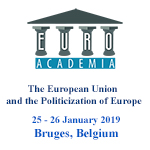Euroacademia Conferences
 Europe Inside-Out: Europe and Europeanness Exposed to Plural Observers (9th Edition) April 24 - 25, 2020
Europe Inside-Out: Europe and Europeanness Exposed to Plural Observers (9th Edition) April 24 - 25, 2020 Identities and Identifications: Politicized Uses of Collective Identities (9th Edition) June 12 - 13, 2020
Identities and Identifications: Politicized Uses of Collective Identities (9th Edition) June 12 - 13, 2020 8th Forum of Critical Studies: Asking Big Questions Again January 24 - 25, 2020
8th Forum of Critical Studies: Asking Big Questions Again January 24 - 25, 2020 Re-Inventing Eastern Europe (7th Edition) December 13 - 14, 2019
Re-Inventing Eastern Europe (7th Edition) December 13 - 14, 2019 The European Union and the Politicization of Europe (8th Edition) October 25 - 26, 2019
The European Union and the Politicization of Europe (8th Edition) October 25 - 26, 2019 Identities and Identifications: Politicized Uses of Collective Identities (8th Edition) June 28 - 29, 2019
Identities and Identifications: Politicized Uses of Collective Identities (8th Edition) June 28 - 29, 2019 The European Union and the Politicization of Europe (7th Edition) January 25 - 26, 2019
The European Union and the Politicization of Europe (7th Edition) January 25 - 26, 2019 7th Forum of Critical Studies: Asking Big Questions Again November 23 - 24, 2018
7th Forum of Critical Studies: Asking Big Questions Again November 23 - 24, 2018 Europe Inside-Out: Europe and Europeanness Exposed to Plural Observers (8th Edition) September 28 - 30, 2018
Europe Inside-Out: Europe and Europeanness Exposed to Plural Observers (8th Edition) September 28 - 30, 2018 Identities and Identifications: Politicized Uses of Collective Identities (7th Edition) June 14 - 15, 2018
Identities and Identifications: Politicized Uses of Collective Identities (7th Edition) June 14 - 15, 2018
A Liberal Intergovernmental Approach to the Establishment of the European Stability Mechanism
-
-

-
Presentation speakers
- Madeleine Hosli, United Nations University – CRIS, Bruges, Belgium / Leiden University, Netherlands
- Wen Pan, Sichuan University, China
- Michael Lantmeeters, United Nations University – CRIS, Bruges, Belgium
- Download presentation
Abstract:
The European Union (EU) was both created by and developed through a series of Treaties signed by participating nation states where intergovernmental bargaining prevails. Liberal Intergovernmentalism (LI) is an influential European integration theory which aims to account for EU milestone developments and policy outcomes forged by intergovernmental negotiations among EU member states. The establishment of the European Stability Mechanism (ESM) — a permanent rescue mechanism purposely adopted to counter the Eurozone sovereign debt crisis via a series of intergovernmental negotiations — represents a typical case of EU development achieved through interstate bargaining among Eurozone countries. Utilizing the research methods of congruence testing and process-tracing, this paper examines LI’s analytical and predictive power in explaining the creation of the ESM. The research results show that the three-phase LI model works well in accounting for the formation of the ESM. Based on the case study of the ESM, several new factors and causal mechanisms are proposed as additions to the LI model, illustrating the validity and vigour of LI as an EU integration theory, as it has developed alongside the empirical progress of the European integration project.
-
Related Presentations













